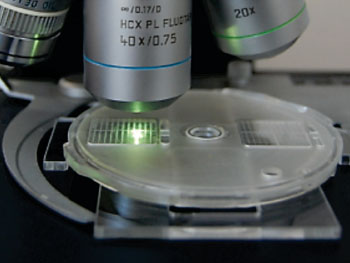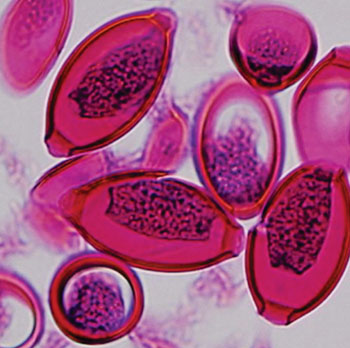Device Diagnostics of Fixed Soil-Transmitted Helminth Infection Assessed
|
By LabMedica International staff writers Posted on 26 Apr 2015 |

Image: The Mini-FLOTAC device for examining stool samples for helminths (Photo courtesy of Public Health Laboratory Ivo de Carneri).

Image: Trichuris trichiura eggs inside a female worm from an infected individual (Photo courtesy of New York University).
Kato-Katz is a widely used method for the diagnosis of soil-transmitted helminth infection, but fecal samples cannot be preserved, and hence, should be processed on the day of collection and examined under a microscope within 60 minutes of slide preparation.
The possibility of collecting fecal specimens in the field, adding a fixative, and analyzing the samples several days later in a central laboratory could overcome the time limitation of working on fresh samples, and hence improve the easiness and the quality of soil-transmitted helminthiasis diagnosis.
Scientists at the Swiss Tropical and Public Health Institute (Basel, Switzerland) and their colleagues enrolled 41 children and their stool samples were subjected on the day of collection to a single Kato-Katz thick smear and Mini-FLOTAC examination. Twelve aliquots of stool were fixed in 5% formalin and subsequently examined by Mini-FLOTAC up to 31 days after collection. The study was carried out in late 2013 on Pemba Island (Tanzania).
The combined results from Kato-Katz and Mini-FLOTAC revealed that 100% of children were positive for Trichuris trichiura, 85% for Ascaris lumbricoides, and 54% for hookworm. Kato-Katz and Mini-FLOTAC techniques found similar prevalence estimates for A. lumbricoides (85% versus 76%), T. trichiura (98% versus 100%), and hookworm (42% versus 51%). The mean eggs per gram of stool (EPG) according to Kato-Katz and Mini-FLOTAC was 12,075 and 11,679 for A. lumbricoides, 1,074 and 1,592 for T. trichiura, and 255 and 220 for hookworm, respectively. The mean EPG from day 1 to 31 of fixation was stable for A. lumbricoides and T. trichiura, but gradually declined for hookworm, starting at day 15.
The authors conclude that for a qualitative diagnosis of soil-transmitted helminth infection, stool samples can be fixed in 5% formalin for at least 30 days. However, for an accurate quantitative diagnosis of hookworm, they suggest a limit of 15 days of preservation. Their results have direct implication for integrating soil-transmitted helminthiasis into transmission assessment surveys for lymphatic filariasis. The study was published on April 7, 2015, in the journal Public Library of Science Neglected Tropical Diseases.
Related Links:
Swiss Tropical and Public Health Institute
The possibility of collecting fecal specimens in the field, adding a fixative, and analyzing the samples several days later in a central laboratory could overcome the time limitation of working on fresh samples, and hence improve the easiness and the quality of soil-transmitted helminthiasis diagnosis.
Scientists at the Swiss Tropical and Public Health Institute (Basel, Switzerland) and their colleagues enrolled 41 children and their stool samples were subjected on the day of collection to a single Kato-Katz thick smear and Mini-FLOTAC examination. Twelve aliquots of stool were fixed in 5% formalin and subsequently examined by Mini-FLOTAC up to 31 days after collection. The study was carried out in late 2013 on Pemba Island (Tanzania).
The combined results from Kato-Katz and Mini-FLOTAC revealed that 100% of children were positive for Trichuris trichiura, 85% for Ascaris lumbricoides, and 54% for hookworm. Kato-Katz and Mini-FLOTAC techniques found similar prevalence estimates for A. lumbricoides (85% versus 76%), T. trichiura (98% versus 100%), and hookworm (42% versus 51%). The mean eggs per gram of stool (EPG) according to Kato-Katz and Mini-FLOTAC was 12,075 and 11,679 for A. lumbricoides, 1,074 and 1,592 for T. trichiura, and 255 and 220 for hookworm, respectively. The mean EPG from day 1 to 31 of fixation was stable for A. lumbricoides and T. trichiura, but gradually declined for hookworm, starting at day 15.
The authors conclude that for a qualitative diagnosis of soil-transmitted helminth infection, stool samples can be fixed in 5% formalin for at least 30 days. However, for an accurate quantitative diagnosis of hookworm, they suggest a limit of 15 days of preservation. Their results have direct implication for integrating soil-transmitted helminthiasis into transmission assessment surveys for lymphatic filariasis. The study was published on April 7, 2015, in the journal Public Library of Science Neglected Tropical Diseases.
Related Links:
Swiss Tropical and Public Health Institute
Latest Microbiology News
- Breakthrough Diagnostic Technology Identifies Bacterial Infections with Almost 100% Accuracy within Three Hours
- Innovative ID/AST System to Help Diagnose Infectious Diseases and Combat AMR
- Gastrointestinal Panel Delivers Rapid Detection of Five Common Bacterial Pathogens for Outpatient Use
- Rapid PCR Testing in ICU Improves Antibiotic Stewardship
- Unique Genetic Signature Predicts Drug Resistance in Bacteria
- Unique Barcoding System Tracks Pneumonia-Causing Bacteria as They Infect Blood Stream
- Rapid Sepsis Diagnostic Test Demonstrates Improved Patient Care and Cost Savings in Hospital Application
- Rapid Diagnostic System to Detect Neonatal Sepsis Within Hours
- Novel Test to Diagnose Bacterial Pneumonia Directly from Whole Blood
- Interferon-γ Release Assay Effective in Patients with COPD Complicated with Pulmonary Tuberculosis
- New Point of Care Tests to Help Reduce Overuse of Antibiotics
- 30-Minute Sepsis Test Differentiates Bacterial Infections, Viral Infections, and Noninfectious Disease
- CRISPR-TB Blood Test to Enable Early Disease Diagnosis and Public Screening
- Syndromic Panel Provides Fast Answers for Outpatient Diagnosis of Gastrointestinal Conditions
- Culture-Free Platform Rapidly Identifies Blood Stream Infections
- POC PCR Test Rapidly Detects Bacterial Meningitis Directly at Point of Sample Collection
Channels
Clinical Chemistry
view channel
Carbon Nanotubes Help Build Highly Accurate Sensors for Continuous Health Monitoring
Current sensors can measure various health indicators, such as blood glucose levels, in the body. However, there is a need to develop more accurate and sensitive sensor materials that can detect lower... Read more
Paper-Based Device Boosts HIV Test Accuracy from Dried Blood Samples
In regions where access to clinics for routine blood tests presents financial and logistical obstacles, HIV patients are increasingly able to collect and send a drop of blood using paper-based devices... Read moreMolecular Diagnostics
view channel
D-Dimer Testing Can Identify Patients at Higher Risk of Pulmonary Embolism
Pulmonary embolism (PE) is a commonly suspected condition in emergency departments (EDs) and can be life-threatening if not diagnosed correctly. Achieving an accurate diagnosis is vital for providing effective... Read more
New Biomarkers to Improve Early Detection and Monitoring of Kidney Injury
Drug-induced kidney injury, also known as nephrotoxicity, is a prevalent issue in clinical practice, occurring when specific medications at certain doses cause damage to the kidneys. Nephrotoxicity can... Read moreHematology
view channel
New Scoring System Predicts Risk of Developing Cancer from Common Blood Disorder
Clonal cytopenia of undetermined significance (CCUS) is a blood disorder commonly found in older adults, characterized by mutations in blood cells and a low blood count, but without any obvious cause or... Read more
Non-Invasive Prenatal Test for Fetal RhD Status Demonstrates 100% Accuracy
In the United States, approximately 15% of pregnant individuals are RhD-negative. However, in about 40% of these cases, the fetus is also RhD-negative, making the administration of RhoGAM unnecessary.... Read moreImmunology
view channel
Post-Treatment Blood Test Could Inform Future Cancer Therapy Decisions
In the ongoing advancement of personalized medicine, a new study has provided evidence supporting the use of a tool that detects cancer-derived molecules in the blood of lung cancer patients years after... Read more
Cerebrospinal Fluid Test Predicts Dangerous Side Effect of Cancer Treatment
In recent years, cancer immunotherapy has emerged as a promising approach where the patient's immune system is harnessed to fight cancer. One form of immunotherapy, called CAR-T-cell therapy, involves... Read more
New Test Measures Preterm Infant Immunity Using Only Two Drops of Blood
Preterm infants are particularly vulnerable due to their organs still undergoing development, which can lead to difficulties in breathing, eating, and regulating body temperature. This is especially true... Read more
Simple Blood Test Could Help Choose Better Treatments for Patients with Recurrent Endometrial Cancer
Endometrial cancer, which develops in the lining of the uterus, is the most prevalent gynecologic cancer in the United States, affecting over 66,000 women annually. Projections indicate that in 2025, around... Read morePathology
view channel
AI Model Predicts Patient Response to Bladder Cancer Treatment
Each year in the United States, around 81,000 new cases of bladder cancer are diagnosed, leading to approximately 17,000 deaths annually. Muscle-invasive bladder cancer (MIBC) is a severe form of bladder... Read more
New Laser-Based Method to Accelerate Cancer Diagnosis
Researchers have developed a method to improve cancer diagnostics and other diseases. Collagen, a key structural protein, plays various roles in cell activity. A novel multidisciplinary study published... Read more
New AI Model Predicts Gene Variants’ Effects on Specific Diseases
In recent years, artificial intelligence (AI) has greatly enhanced our ability to identify a vast number of genetic variants in increasingly larger populations. However, up to half of these variants are... Read more
Powerful AI Tool Diagnoses Coeliac Disease from Biopsy Images with Over 97% Accuracy
Coeliac disease is an autoimmune disorder triggered by the consumption of gluten, causing symptoms such as stomach cramps, diarrhea, skin rashes, weight loss, fatigue, and anemia. Due to the wide variation... Read moreTechnology
view channel
Smartphones Could Diagnose Diseases Using Infrared Scans
Rapid advancements in technology may soon make it possible for individuals to bypass invasive medical procedures by simply uploading a screenshot of their lab results from their phone directly to their doctor.... Read more
Novel Sensor Technology to Enable Early Diagnoses of Metabolic and Cardiovascular Disorders
Metabolites are critical compounds that fuel life's essential functions, playing a key role in producing energy, regulating cellular activities, and maintaining the balance of bodily systems.... Read more
3D Printing Breakthrough Enables Large Scale Development of Tiny Microfluidic Devices
Microfluidic devices are diagnostic systems capable of analyzing small volumes of materials with precision and speed. These devices are used in a variety of applications, including cancer cell analysis,... Read moreIndustry
view channel




















